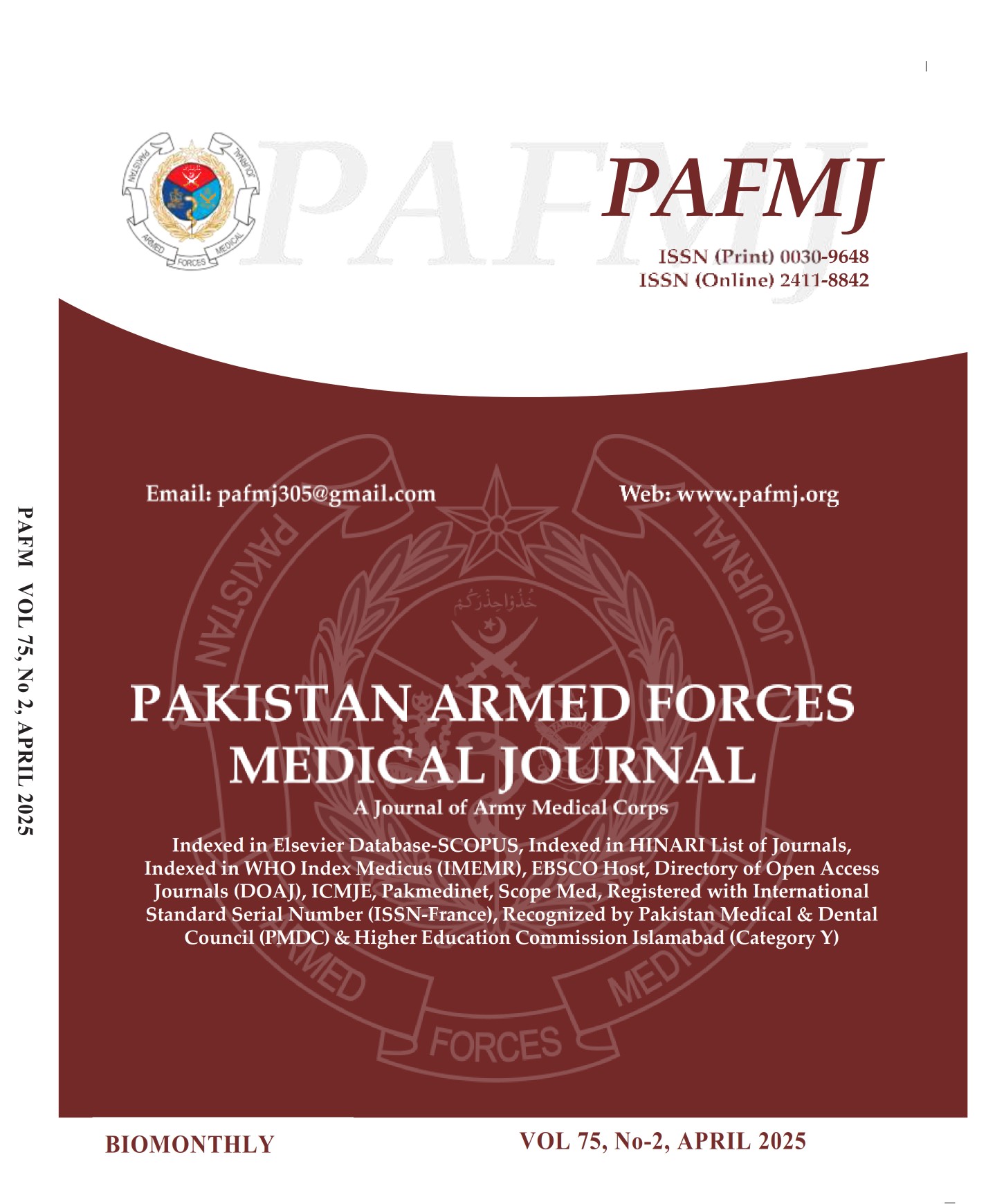Comparison of Efficacy of Angiotensin-Converting Enzyme Inhibitors (ACEIs) and Angiotensin Receptor Blockers (ARBs) in Delaying Diabetic Nephropathy
DOI:
https://doi.org/10.51253/pafmj.v75i2.9146Keywords:
Angiotensin-Converting Enzyme Inhibitors (ACEIs), Albumin-creatinine ratio, Angiotensin Receptor Blockers (ARBs), Diabetic nephropathyAbstract
Objective: To compare the effect of angiotensin‐converting enzyme inhibitors and angiotensin receptor blockers on renal damage in terms of change in mean albumin-to-creatinine ratio.
Study Design: Cross-sectional study.
Study Place and Duration: PNS Hafeez, Islamabad, Pakistan, from Feb to Jul 2021.
Methodology: We included 1300 patients using non-probability purposive sampling, divided into two groups. Patients aged between 30-60 years, suffering from Type 2 Diabetes Mellitus with detectable microalbuminuria having Urine Albumin to Creatinine Ratio >30mg/g, before starting the medication with either angiotensin‐converting enzyme inhibitors or ARB, were considered for inclusion. Patients with ischemic heart disease, vasculitis, glomerulonephritis, protein-losing enteropathy, liver disease, malignancy, urinary tract infection, and any contraindication of ACE inhibitor and ARBs were excluded.
Results: In Group A, the duration of disease was 9.22±3.45 years, and in Group B, it was 9.11±3.58 years. The delay in nephropathy progression between the two groups was established by measuring the mean change in ACR after 3 months in both groups. It was established that angiotensin‐converting enzyme inhibitors (mean change 0.93±0.16 mg/g) was adequately efficient in delaying the albuminuria over three months of treatment than ARBS (mean change 1.097±0.26 mg/g) (p˂ .001).
Conclusion: In comparison, angiotensin‐converting enzyme inhibitors were more adequate than angiotensin receptor blockers in creating change in mean albumin-to-creatinine ratio.
Downloads
References
Cho NH, Shaw JE, Karuranga S, et al. IDF Diabetes Atlas: Global estimates of diabetes prevalence for 2017 and projections for 2045. Diabetes Res Clin Pract 2018; 138: 271-281.
https://doi.org/10.1016/j.diabres.2018.02.023
Sun H, Saeedi P, Karuranga S, et al. IDF Diabetes Atlas: Global, regional and country-level diabetes prevalence estimates for 2021 and projections for 2045. Diabetes Res Clin Pract 2022; 183: 109119.
https://doi.org/10.1016/j.diabres.2021.109119
Umanath K, Lewis JB. Update on Diabetic Nephropathy: Core Curriculum 2018. Am J Kidney Dis 2018; 71(6): 884-895.
https://doi.org/10.1053/j.ajkd.2017.10.026
Zhang XX, Kong J, Yun K. Prevalence of Diabetic Nephropathy among Patients with Type 2 Diabetes Mellitus in China: A Meta-Analysis of Observational Studies. J Diabetes Res 2020; 2020: 2315607.
https://doi.org/10.1155/2020/2315607
Aldukhayel A. Prevalence of diabetic nephropathy among Type 2 diabetic patients in some of the Arab countries. Int J Health Sci 2017; 11(1): 1-4.
Yaqub S, Kashif W, Raza MQ et al. General practitioners' knowledge and approach to chronic kidney disease in Karachi, Pakistan. Indian J Nephrol 2013; 23(3): 184-190.
https://doi.org/10.4103/0971-4065.115131
Abro M, Zafar AB, Fawwad A et al. Prevalence of diabetic microvascular complications at a tertiary care unit Karachi, Pakistan. Int J Diabetes Dev Ctries 2019; 39(2): 325-330.
https://doi.org/10.1007/s13410-018-0683-5
Tahir M, Hassan WU, Alam HM. Comparison of efficacy of angiotensin converting enzyme inhibitor (ACEIs) vs angiotensin II receptor blockers (ARBs) in management of microalbuminuria among normotensive type 2 diabetic patients. Pak Armed Forces Med J 2016; 66(2): 258-261.
Wang K, Hu J, Luo T et al. Effects of Angiotensin-Converting Enzyme Inhibitors and Angiotensin II Receptor Blockers on All-Cause Mortality and Renal Outcomes in Patients with Diabetes and Albuminuria: a Systematic Review and Meta-Analysis. Kidney Blood Press Res 2018; 43(3): 768-779.
https://doi.org/10.1159/000489827
Zafar S, Khan MK, Pervaiz A et al. Antihypertensive Medication Prescription Patterns and Cost Minimization Possibilities in Pakistan. Lat Am J Pharm 2020; 39(9): 1766-1771.
Wu AY, Kong NC, De Leon FA et al. An alarmingly high prevalence of diabetic nephropathy in Asian type 2 diabetic patients: the MicroAlbuminuria Prevalence (MAP) Study. Diabetologia 2005;48(1):17-26.
https://doi.org/10.1007/s00125-004-1607-8
Patil P, Shah V, Shah B. Comparison of spot urine protein creatinine ratio with 24 hour urine protein for estimation of proteinuria. J Assoc Physicians India 2014; 62(5): 406-410.
Kamińska J, Dymicka-Piekarska V, Tomaszewska J et al. Diagnostic utility of protein to creatinine ratio (P/C ratio) in spot urine sample within routine clinical practice. Crit Rev Clin Lab Sci 2020; 57(5): 345-364.
https://doi.org/10.1080/10408363.2020.1776676
Zheng CM, Wang JY, Chen TT et al. Author Correction: Angiotensin-converting enzyme inhibitors or angiotensin receptor blocker monotherapy retard deterioration of renal function in Taiwanese chronic kidney disease population. Sci Rep 2020;10(1):6631.
https://doi.org/10.1038/s41598-020-63162-w
Zhang Y, He D, Zhang W et al. ACE Inhibitor Benefit to Kidney and Cardiovascular Outcomes for Patients with Non-Dialysis Chronic Kidney Disease Stages 3-5: A Network Meta-Analysis of Randomised Clinical Trials. Drugs 2020;80(8):797-811. https://doi.org/10.1007/s40265-020-01292-3
Liu Y, Ma X, Zheng J et al. Effects of angiotensin-converting enzyme inhibitors and angiotensin receptor blockers on cardiovascular events and residual renal function in dialysis patients: a meta-analysis of randomised controlled trials. BMC Nephrol 2017; 18(1): 206.
https://doi.org/10.1186/s12882-017-0619-4
Coleman CI, Weeda ER, Kharat A et al. Impact of angiotensin‐converting enzyme inhibitors or angiotensin receptor blockers on renal and mortality outcomes in people with Type 2 diabetes and proteinuria. Diabetic Medicine. 2020; 37(1): 44-52.
Agustina PS, Yunir E, Prawiroharjo P, et al. Comparison of effects of ACEIs and ARBs on albuminuria and hyperkalemia in Indonesian hypertensive type 2 diabetes mellitus patients. Int J Hypertens 2020: 5342161.
https://doi.org/10.1155/2020/5342161
Puspita FM, Yunir E, Agustina PS, et al. Effect of angiotensin receptor blocker and angiotensin converting enzyme inhibitor on kidney function and blood potassium level in Indonesian type 2 diabetes mellitus with hypertension: A three-month cohort study. Diabetes Metab Syndr Obes 2021; 14: 3841-3849.
https://doi.org/10.2147/DMSO.S325109
Elsafa E, Ali PZ. Protective effect of angiotensin-converting enzyme inhibitors (ACEIs) and angiotensin II receptor antagonists (ARBs) on microalbuminuria in diabetic patients. Clin Diabetol 2020; 9(3): 193-200.
https://doi.org/10.5603/DK.2020.0019
Ruggenenti P, Trillini M, Barlovic DP, et al. Effects of valsartan, benazepril and their combination in overt nephropathy of type 2 diabetes: A prospective, randomized, controlled trial. Diabetes Obes Metab 2019; 21(5): 1177-1190.
Downloads
Published
Issue
Section
License
Copyright (c) 2025 Fraz Tahir, Syeda Arsheen Rizvi, Faisal Naveed Akhtar

This work is licensed under a Creative Commons Attribution-NonCommercial 4.0 International License.















